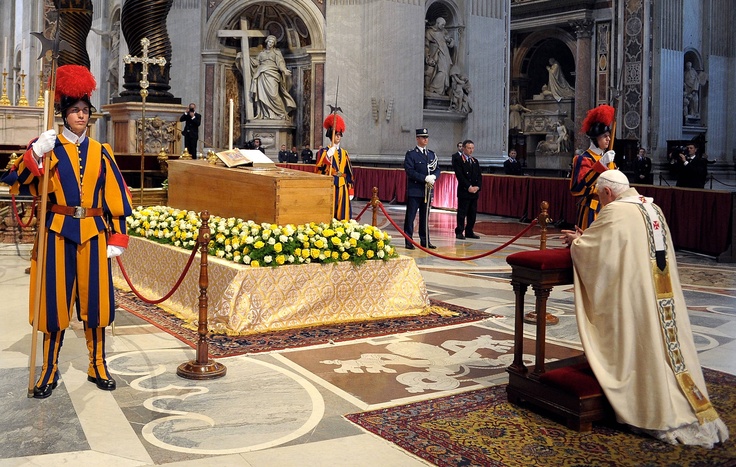LIFESTYLE

WHY POPES WERE BURIED IN 3 COFFINS WITH A BAG OF COINS—AND HOW POPE FRANCIS ENDED THE TRADITION
For centuries, the burial of popes followed a meticulously crafted ritual steeped in symbolism and tradition. The use of three nested coffins and a bag of coins was not merely ceremonial but carried profound theological and practical significance. This practice, which endured for generations, was dramatically altered in 2024 when Pope Francis introduced reforms that emphasized humility and simplicity over grandeur.
The Historical Significance of the Three Coffins
The tradition of burying popes in three coffins dates back to the early centuries of the Catholic Church. Each coffin served a distinct purpose, both symbolic and practical, reflecting the pope’s spiritual role, earthly authority, and human mortality.
1. The Cypress Coffin
The innermost coffin, crafted from plain cypress wood, symbolized humility and mortality. It served as a reminder that even the most powerful spiritual leader is human and destined to return to dust. Inside the cypress coffin, three bags of coins—gold, silver, and copper—were placed, each containing coins equal to the number of years the pope served. This gesture represented the pope’s service to the Church and his earthly contributions. Additionally, a written biography (rogito) rolled into a metal tube and a white silk veil covering the pope’s face were included, signifying his spiritual legacy.
2. The Lead Coffin
The second layer, made of lead or zinc, was both practical and symbolic. It preserved the pope’s remains and safeguarded important papal documents, including the broken papal seal. The lead coffin was engraved with the pope’s name, dates of pontificate, and often a skull and crossbones—a traditional memento mori reminding the faithful of human mortality. This layer acted as an impenetrable shield against tampering or decay, ensuring the pope’s legacy was preserved for posterity.
3. The Elm or Oak Coffin
The outermost coffin, crafted from strong elm or oak, represented the dignity and strength of the papacy. It was nailed shut with golden nails and adorned with a golden cross and the papal coat of arms. Before sealing, a parchment listing the pope’s achievements was placed inside, serving as a historical record of his contributions to the Church and the world.
Together, these three coffins encapsulated the pope’s life, death, and legacy in a deeply symbolic and durable manner. The ritual was a powerful testament to the pope’s multifaceted role as a spiritual leader, a temporal authority, and a mortal being.
Pope Francis’ Groundbreaking Reforms
In 2024, Pope Francis made a historic decision to abolish the three-coffin tradition, signaling a shift toward humility and simplicity in papal funerals. His reforms were part of the revised *Ordo Exsequiarum Romani Pontificis* (Rite of Burial for Roman Pontiffs), which emphasized the pope’s pastoral identity over his worldly status.
Key Changes Introduced by Pope Francis
Single Coffin Burial: Instead of three coffins, Pope Francis opted for a single wooden coffin with a zinc lining. This choice preserved the body while eliminating the grandeur associated with the traditional burial.
Simplified Funeral Setup: Pope Francis declined to be displayed on an elevated bier, preferring a more humble arrangement where his body faced the congregation and was accompanied by the Paschal candle.
Personal Burial Site: Pope Francis expressed his wish to be buried at the Basilica of St. Mary Major, a site of personal significance to him, rather than inside the Vatican.
Monsignor Diego Ravelli, the Vatican’s Master of Liturgical Ceremonies, explained that the reforms were intended to emphasize the pope’s role as a shepherd and disciple rather than a worldly monarch. This shift reflected Pope Francis’ lifelong commitment to modesty and service.
The Legacy of Pope Francis’ Reforms
Pope Francis’ decision to end the three-coffin tradition marked a profound departure from centuries of papal burial practices. His reforms were consistent with his broader vision of a simpler, more pastoral papacy. By prioritizing humility and spiritual values over material grandeur, Pope Francis redefined how the world’s most powerful religious leader is remembered.
While the changes surprised many Catholics, they align with the evolving nature of traditions within the Church. Pope Francis’ legacy will undoubtedly continue to inspire discussions about the essence of leadership, humility, and service in the modern era.
"This represents a significant development in our ongoing coverage of current events."— Editorial Board









